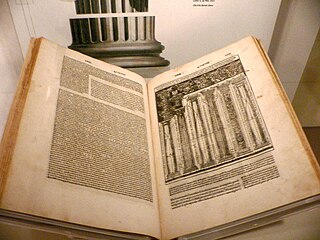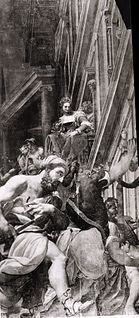
Donato Bramante, born as Donato di Pascuccio d'Antonio and also known as Bramante Lazzari, was an Italian architect and painter. He introduced Renaissance architecture to Milan and the High Renaissance style to Rome, where his plan for St. Peter's Basilica formed the basis of design executed by Michelangelo. His Tempietto marked the beginning of the High Renaissance in Rome (1502) when Pope Julius II appointed him to build a sanctuary over the spot where Peter was martyred.

Bartolomeo Suardi, best known as Bramantino, was an Italian painter and architect, mainly active in his native Milan.

Bernardo Buontalenti, byname of Bernardo Delle Girandole, was an Italian stage designer, architect, theatrical designer, military engineer and artist and inventor of italian ice cream.

Pellegrino Tibaldi, also known as Pellegrino di Tibaldo de Pellegrini, was an Italian mannerist architect, sculptor, and mural painter.

Francesco di Giorgio Martini (1439–1501) was an Italian architect, engineer, painter, sculptor, and writer. As a painter, he belonged to the Sienese School. He was considered a visionary architectural theorist—in Nikolaus Pevsner's terms: "one of the most interesting later Quattrocento architects". As a military engineer, he executed architectural designs and sculptural projects and built almost seventy fortifications for the Federico da Montefeltro, Count of Urbino, building city walls and early examples of star-shaped fortifications.

Cesare di Lorenzo Cesariano (1475–1543) was an Italian painter, architect and architectural theorist. He authored the first Italian-language version of Vitruvius' De architectura.

Camillo Boito was an Italian architect and engineer, and a noted art critic, art historian and novelist.

The Galli-Bibiena family, or Galli da Bibiena, was a family of Italian artists of the 17th and 18th centuries, including:

Žale Central Cemetery, often simply Žale, is the largest and the central cemetery in Ljubljana and Slovenia. It is located in the Bežigrad District and operated by the Žale Public Company.

Girolamo da Treviso, also known as Girolamo di Tommaso da Treviso the Younger and Girolamo Trevigi, was an Italian Renaissance sculptor and painter in Henry VIII's court in England.

Giuseppe Meda, originally Giuseppe Lomazzo was an Italian painter, architect and hydraulics engineer.

Luigi Baccio del Bianco or Baccio del Bianco was an Italian architect, engineer, scenic designer and painter.
Events from the year 1511 in art.
Events from the year 1941 in Denmark.

Vjenceslav Richter was a Croatian architect. He was also known for his work in the fields of urbanism, sculpture, graphic arts, painting and stage design.
Bartolomeo Neroni, also known as Il Riccio or Riccio Sanese (c.1505-1571) was an Italian painter, sculptor, architect and engineer of the Sienese School. He was born and died in Siena.
Events from the year 1855 in Scotland.
Peter Henricus Theodorus (Pierre) Tetar Elven was a Dutch painter and draftsman of the 19th century, with a preference for architecture, landscapes, and Italian cityscapes (vedutas). He also painted a few genre pieces for French high society.













